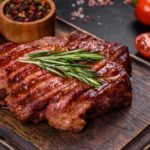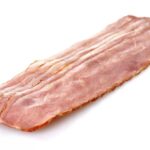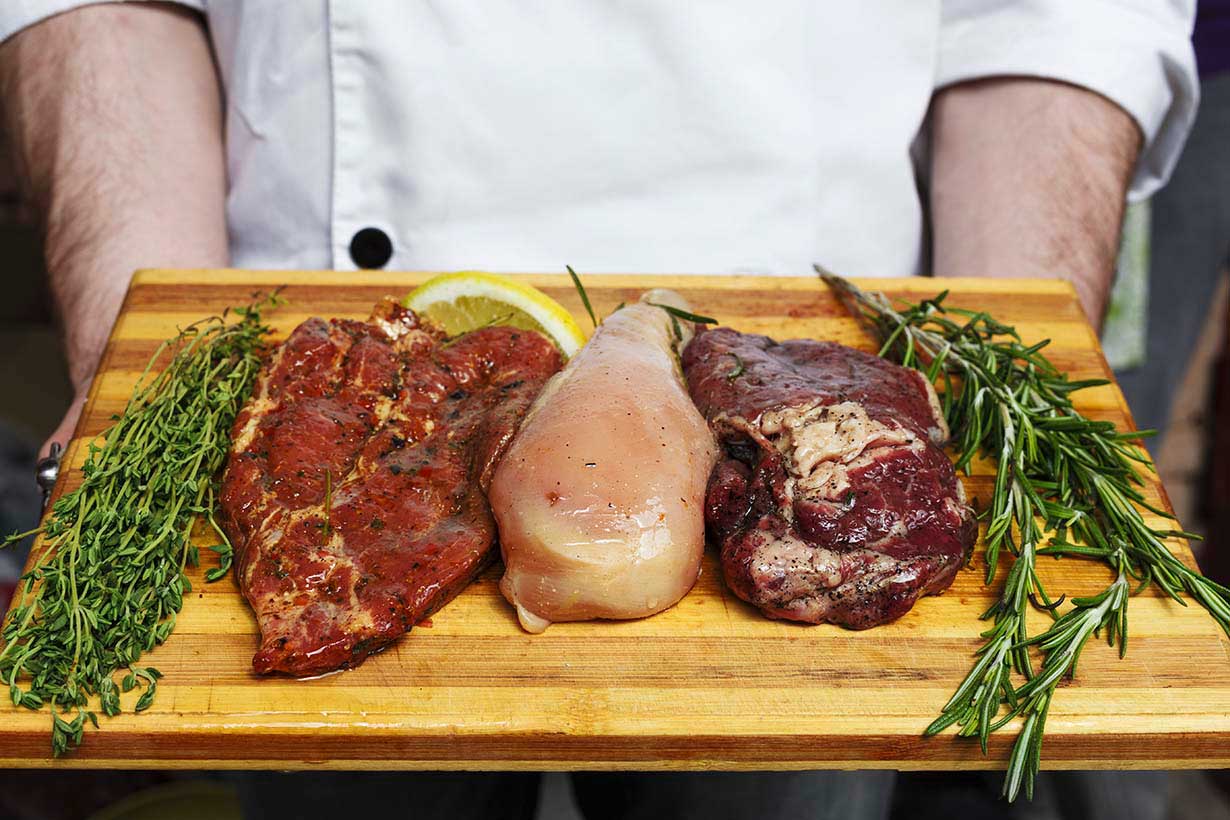Bacon is a popular meat typically made by salt-curing pork. However, bacon comes in various forms and can be made from different meats like turkey and beef.
There are also different cuts of bacon available, including back bacon, reduced-fat options, low-sodium varieties, and even meatless alternatives.
The nutritional values of these bacon types can vary significantly, which may come as a surprise.
We all have different goals when it comes to our dietary choices, whether it’s reducing sodium, increasing protein intake, or lowering fat and calorie consumption. For this purpose, this article provides a comprehensive guide to 12 types of bacon and their nutritional profiles.
Types of Bacon and Their Nutritional Values
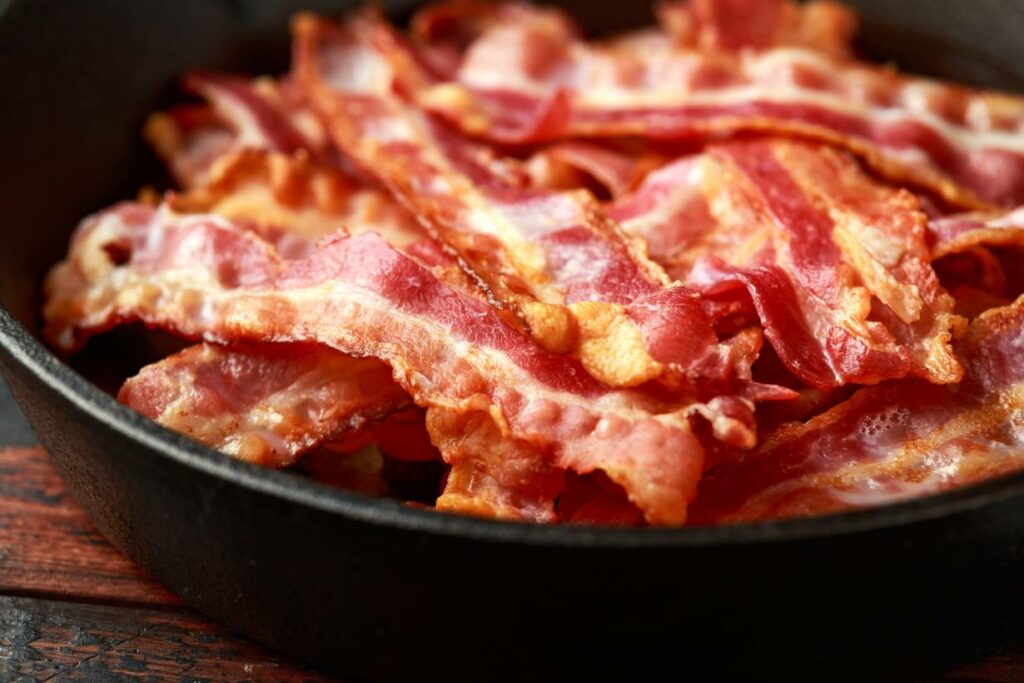
Each bacon variety in this guide includes essential nutrition information such as calories, carbohydrates, fat, protein, cholesterol, and sodium content.
Please note that all nutritional values are based on cooked weight.
We have obtained the nutritional data from three trusted databases:
- FoodData Central (USDA)
- NCC Food and Nutrient Database (the University of Minnesota)
- Composition of Foods Integrated Dataset (Public Health England)
If you click on any of the links above, you will find more detailed information about each database.
The percent daily values (% DV) have been calculated using the FDA’s published daily values.
1) Pork bacon, belly, cured
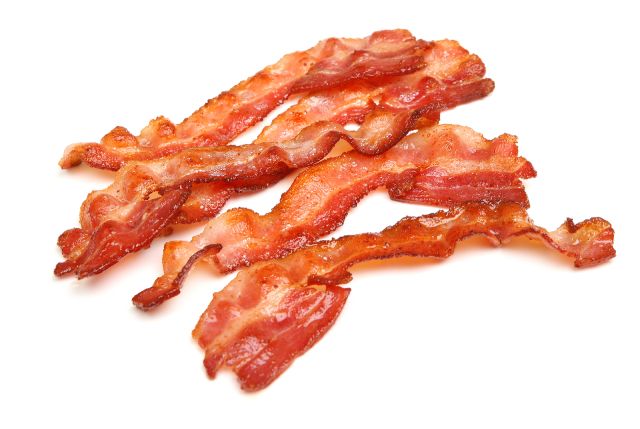
Salt-cured bacon made from pork belly is one of the most widely consumed bacon varieties globally.
The majority of calories in pork belly bacon can be attributed to its fat content.
The table presented below displays the nutritional values for cured pork bacon per 100 grams and per 8-gram slice (1):
| Name | Per 100g | % DV | Per slice | % DV |
|---|---|---|---|---|
| Calories | 468 kcal | 44 kcal | ||
| Carbohydrate | 1.7 g | <1% | 0.1 g | <1% |
| Fiber | 0 g | 0% | 0 g | 0% |
| Sugar | 0 g | 0 g | ||
| Fat | 35.1 g | 45% | 3.51 g | 5% |
| Saturated | 12.0 g | 60% | 1.15 g | 6% |
| Monounsaturated | 15.5 g | 1.55 g | ||
| Polyunsaturated | 6.11 g | 0.39 g | ||
| Omega-3 | 0.21 g | 0.02 g | ||
| Omega-6 | 4.29 g | 0.35 g | ||
| Protein | 35.7 g | 71% | 2.89 g | 6% |
| Cholesterol | 107 mg | 36% | 8.67 g | 3% |
| Sodium | 2190 mg | 95% | 177 mg | 8% |
Learn more about pork bacon in this nutritional guide
2) Pork bacon, belly, fresh
Fresh bacon, unlike cured bacon, may not always contain preservatives like sodium nitrate and sodium nitrite. However, it still contains a significant amount of salt, leading to a high sodium content.
In terms of flavor, fresh bacon has a milder taste compared to its cured counterpart, essentially being thinly-sliced and salted pork belly.
One drawback of fresh bacon is its shorter shelf life compared to cured bacon, if it lacks preservatives.
The nutritional profile provided below outlines the values for fresh pork belly per 100 grams and per 8-gram medium slice (2):
| Name | Per 100g | % DV | Per slice | % DV |
|---|---|---|---|---|
| Calories | 468 kcal | 37kcal | ||
| Carbohydrate | 1.7 g | <1% | 0.14 g | <1% |
| Fiber | 0 g | 0% | 0 g | 0% |
| Sugar | 0 g | 0 g | ||
| Fat | 35.1 g | 45% | 2.81 g | 3.6% |
| Saturated | 12.0 g | 60% | 0.96 g | 5% |
| Monounsaturated | 15.5 g | 1.24 g | ||
| Polyunsaturated | 6.11 g | 0.49 g | ||
| Omega-3 | 0.23 g | 0.02 g | ||
| Omega-6 | 5.33 g | 0.43 g | ||
| Protein | 33.9 g | 68% | 2.71 g | 5% |
| Cholesterol | 99 mg | 33% | 7.92 g | 3% |
| Sodium | 1680 mg | 73% | 134 mg | 6% |
As the nutritional data shows, there is little difference between fresh and cured bacon.
The most notable difference is the approximately 24% lower sodium content found in fresh bacon compared to cured bacon.
3) Canadian bacon
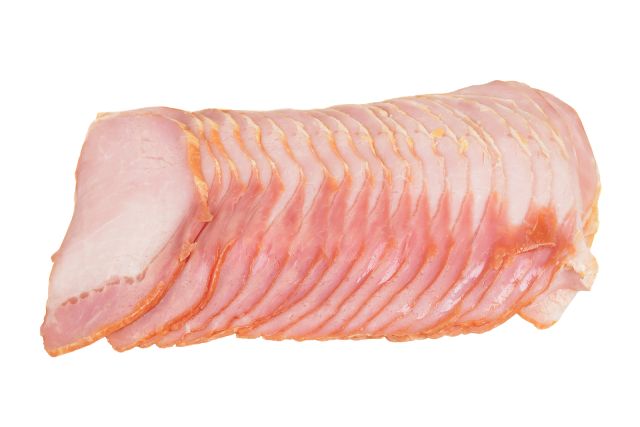
Canadian bacon, despite also being derived from pork, has some key differences. The primary difference is that it originates from the lean eye of the pork loin rather than the pork belly. It undergoes a process of curing, cooking, and seasoning with salt, along with possible additions of herbs and spices.
Since it comes from a different cut of pork, Canadian bacon has clear nutritional distinctions from regular bacon.
Most notably, it contains significantly lower levels of calories and fat when compared to traditional bacon made from pork belly.
Here is the nutritional data for Canadian bacon per 100 grams and per 23-gram slice (3):
| Name | Per 100g | % DV | Per slice | % DV |
|---|---|---|---|---|
| Calories | 146 kcal | 34 kcal | ||
| Carbohydrate | 1.8 g | <1% | 0.41 g | <1% |
| Fiber | 0 g | 0% | 0 g | 0% |
| Sugar | 1.2 g | 0.28 g | ||
| Fat | 2.78 g | 4% | 0.64 g | 1% |
| Saturated | 1.04 g | 5% | 0.24 g | 1% |
| Monounsaturated | 1.26 g | 0.29 g | ||
| Polyunsaturated | 0.49 g | 0.11 g | ||
| Omega-3 | 0.02 g | <0.01 g | ||
| Omega-6 | 0.38 g | 0.09 g | ||
| Protein | 28.31 g | 57% | 6.51 g | 13% |
| Cholesterol | 67.0 mg | 22% | 15.4 mg | 5% |
| Sodium | 993.0 mg | 43% | 228 mg | 10% |
4) Beef bacon
Beef bacon is a type of bacon made from beef rather than pork, making it a suitable option for individuals who avoid pork for religious reasons.
Similar to traditional bacon, beef bacon undergoes a salt-curing process that may involve the addition of spices for seasoning
Since it is a different meat variety, beef bacon possesses a different flavor profile compared to pork bacon. It offers a richer, beefy flavor, and it tends to have a slightly lower fat content as well.
Here are the nutritional values for beef bacon per 100 grams and per 8-gram slice (4):
| Name | Per 100g | % DV | Per slice | % DV |
|---|---|---|---|---|
| Calories | 449 kcal | 36 kcal | ||
| Carbohydrate | 1.4 g | <1% | 0.11 g | <1% |
| Fiber | 0 g | 0% | 0 g | 0% |
| Sugar | 0 g | 0 g | ||
| Fat | 34.4 g | 44% | 2.75 g | 4% |
| Saturated | 14.4 g | 72% | 1.15 g | 6% |
| Monounsaturated | 16.8 g | 1.34 g | ||
| Polyunsaturated | 1.58 g | 0.13 g | ||
| Omega-3 | 0.33 g | 0.03 g | ||
| Omega-6 | 1.25 g | 0.1 g | ||
| Protein | 31.3 g | 63% | 2.5 g | 5% |
| Cholesterol | 119 mg | 40% | 9.52 mg | 3% |
| Sodium | 1500 mg | 65% | 120 mg | 5% |
5) Turkey bacon
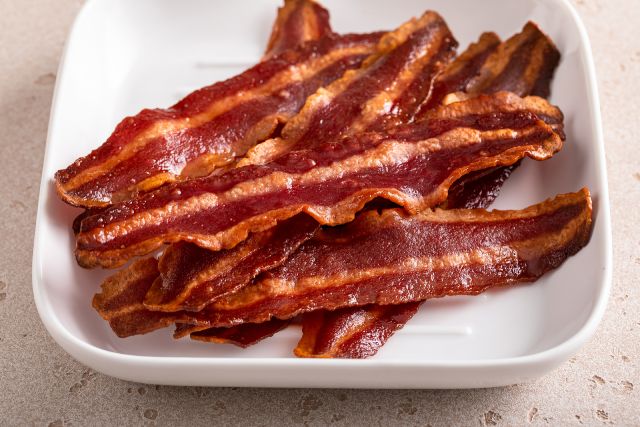
Turkey bacon is a type of bacon that is made from turkey meat instead of pork. It is also a suitable option for individuals who avoid pork bacon for religious reasons, similar to beef bacon.
One of the notable features of turkey bacon is its low-calorie, low-fat, and high-protein content compared to regular pork bacon. These characteristics make turkey bacon an appealing choice for individuals following a diet or seeking additional protein intake, such as athletes.
It offers a distinct taste and texture profile, with a much milder flavor compared to its pork counterpart.
In terms of nutritional values, turkey bacon differs significantly from pork bacon.
Below are the nutritional values for turkey bacon per 100 grams and per 8-gram slice (5):
| Name | Per 100g | % DV | Per slice | % DV |
|---|---|---|---|---|
| Calories | 368 kcal | 29 kcal | ||
| Carbohydrate | 4.24 g | 2% | 0.34 g | <1% |
| Fiber | 0 g | 0% | 0 g | 0% |
| Sugar | 4.24 g | 0.34 g | ||
| Fat | 25.9 g | 33% | 2.07 g | 3% |
| Saturated | 6.93 g | 35% | 0.55 g | 3% |
| Monounsaturated | 9.38 g | 0.75 g | ||
| Polyunsaturated | 6.87 g | 0.55 g | ||
| Omega-3 | 0.35 g | 0.03 g | ||
| Omega-6 | 6.19 g | 0.51 g | ||
| Protein | 29.5 g | 59% | 2.36 g | 5% |
| Cholesterol | 153 mg | 51% | 12.2 mg | 4% |
| Sodium | 2020 mg | 88% | 162 mg | 7% |
Find out more about turkey bacon in this nutritional guide
6) Back Bacon, (British bacon)
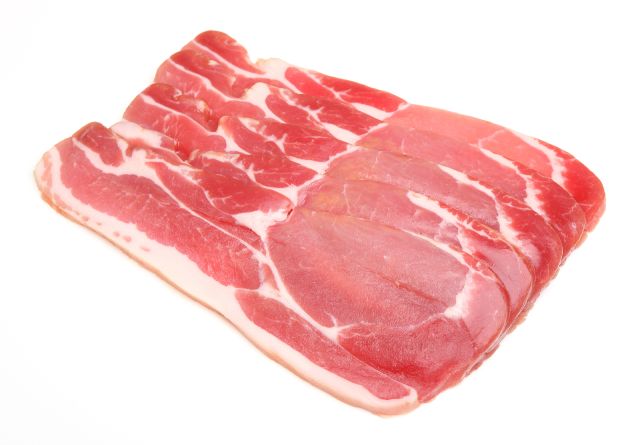
British bacon, also recognized as back bacon or bacon rashers, is a highly popular bacon variety savored in the United Kingdom and certain parts of Europe.
Distinguished from American bacon, British bacon comprises the loin and a small portion of the belly. It is commonly salt-cured and may or may not undergo a smoking process, like other bacon products.
In comparison to American bacon derived from pork belly, British bacon exhibits notably reduced fat content and overall calorie count.
However, it is important to note that back bacon is typically cut thicker and weighs more per slice, resulting in higher calorie and nutrient content.
Below, you will find the nutritional values for British back bacon per 100 grams and per 28-gram slice (6):
| Name | Per 100g | % DV | Per slice | % DV |
|---|---|---|---|---|
| Calories | 285 kcal | 81 kcal | ||
| Carbohydrate | 0 g | 0% | 0 g | 0% |
| Fiber | 0 g | 0% | 0 g | 0% |
| Sugar | 0 g | 0% | ||
| Fat | 21.6 g | 28% | 6.12 g | 8% |
| Saturated | 8.1 g | 41% | 2.3 g | 12% |
| Monounsaturated | 9.0 g | 2.55 g | ||
| Polyunsaturated | 2.8 g | 0.79 g | ||
| Omega-3 | 0.31 g | 0.09 g | ||
| Omega-6 | 2.41 g | 0.68 g | ||
| Protein | 23.2 g | 46% | 6.58 g | 13% |
| Cholesterol | 75 mg | 25% | 21.3 g | 7% |
| Sodium | 1390 mg | 60% | 394 mg | 6% |
7) Back bacon, fat-trimmed
Fat-trimmed bacon refers to bacon where the fatty portion has been trimmed off, leaving only the lean loin part.
This trimming process results in a considerable reduction in fat and overall calorie content.
When compared to regular back bacon, the fat-trimmed variation offers a more pronounced flavor, albeit with a slightly drier and chewier texture due to the decreased fat content.
As a thick-cut bacon option, fat-trimmed back bacon provides the following nutritional values per 100 grams and per 28-gram slice (6):
| Name | Per 100g | % DV | Per slice | % DV |
|---|---|---|---|---|
| Calories | 213 kcal | 60 kcal | ||
| Carbohydrate | 0 g | 0% | 0 g | 0% |
| Fiber | 0 g | 0% | 0 g | 0% |
| Sugar | 0 g | 0 g | ||
| Fat | 12.3 g | 16% | 3.49 g | 4% |
| Saturated | 4.6 g | 23% | 1.3 g | 7% |
| Monounsaturated | 5.2 g | 1.47 g | ||
| Polyunsaturated | 1.6 g | 0.45 g | ||
| Omega-3 | – | – | ||
| Omega-6 | – | – | ||
| Protein | 25.7 g | 51% | 7.29 g | 15% |
| Cholesterol | 44 mg | 15% | 12.47 g | 4% |
| Sodium | 1430 mg | 62% | 405 mg | 18% |
8) Pork bacon, belly, reduced sodium
Reduced-sodium pork bacon shares the same characteristics as regular pork bacon, with the notable exception of its lower sodium content.
This particular bacon variety caters to individuals aiming to decrease their sodium intake.
While reduced-sodium pork bacon still undergoes the traditional salt-curing process, it employs lower amounts of salt. However, it is crucial to recognize that even with the reduction, the sodium content in this type of bacon remains moderately high.
Below, you will find the typical nutritional values for reduced-sodium pork bacon per 100 grams and per 8-gram slice (7):
| Name | Per 100g | % DV | Per slice | % DV |
|---|---|---|---|---|
| Calories | 541 kcal | 43 kcal | ||
| Carbohydrate | 1.43 g | <1% | 0.11 g | <1% |
| Fiber | 0 g | 0% | 0 g | 0% |
| Sugar | 0 g | 0 g | ||
| Fat | 41.8 g | 54% | 3.34 g | 4% |
| Saturated | 13.7 g | 69% | 1.1 g | 6% |
| Monounsaturated | 18.5 g | 1.48 g | ||
| Polyunsaturated | 4.55 g | 0.36 g | ||
| Omega-3 | 4.0 g | 0.02 g | ||
| Omega-6 | 0.2 g | 0.32 g | ||
| Protein | 37.0 g | 74% | 2.96 g | 6% |
| Cholesterol | 110 mg | 37% | 8.8 mg | 3% |
| Sodium | 1030 mg | 45% | 82.4 mg | 4% |
9) Back bacon, reduced sodium
Reduced sodium back bacon is a variety of bacon made from pork loin that undergoes a curing process with lower amounts of salt.
Here is the nutritional profile for reduced sodium back bacon per 100 grams and per 28-gram slice (6):
| Name | Per 100g | % DV | Per slice | % DV |
|---|---|---|---|---|
| Calories | 280 kcal | 79 kcal | ||
| Carbohydrate | 0 g | 0% | 0 g | 0% |
| Fiber | 0 g | 0% | 0 g | 0% |
| Sugar | 0 g | 0 g | ||
| Fat | 20.6 g | 26% | 5.84 g | 7% |
| Saturated | 7.8 g | 39% | 2.21 g | 11% |
| Monounsaturated | 8.7 g | 2.47 g | ||
| Polyunsaturated | 2.7 g | 0.77 g | ||
| Omega-3 | – | – | ||
| Omega-6 | – | – | ||
| Protein | 24.1 g | 48% | 6.83 g | 14% |
| Cholesterol | 74.0 mg | 25% | 20.98 g | 7% |
| Sodium | 1130 mg | 49% | 320 mg | 14% |
10) Turkey bacon, reduced sodium
Reduced sodium turkey bacon shares similarities with regular turkey bacon, but it has less salt added during the curing process.
Here are the nutritional values for reduced sodium turkey bacon per 100 grams and per 8-gram cooked slice (8):
| Name | Per 100g | % DV | Per slice | % DV |
|---|---|---|---|---|
| Calories | 368 kcal | 29 kcal | ||
| Carbohydrate | 4.24 g | 2% | 0.34 g | <1% |
| Fiber | 0 g | 0% | 0 g | 0% |
| Sugar | 4.24 g | 0.34 g | ||
| Fat | 25.87 g | 33% | 2.07 g | 3% |
| Saturated | 6.93 g | 35% | 0.55 g | 3% |
| Monounsaturated | 9.38 g | 0.75 g | ||
| Polyunsaturated | 6.87 g | 0.55 g | ||
| Omega-3 | 0.39 g | 0.03 g | ||
| Omega-6 | 6.29 g | 0.50 g | ||
| Protein | 29.5 g | 59% | 2.36 g | 5% |
| Cholesterol | 153 mg | 51% | 12.24 mg | 4% |
| Sodium | 900 mg | 39% | 72.0 mg | 3% |
11) Plant-based bacon
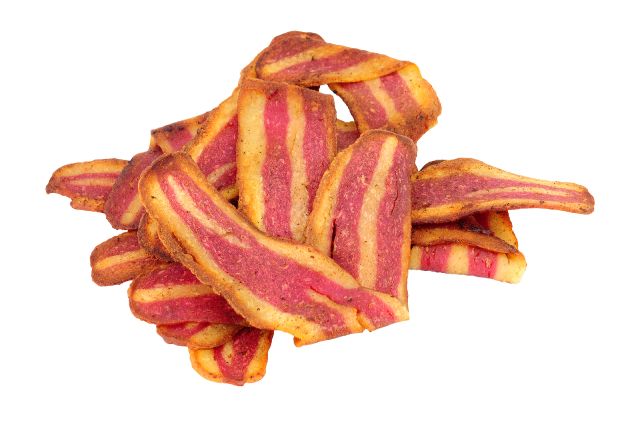
Plant-based bacon, also known as vegetarian bacon, vegan bacon, or meatless bacon, is an alternative to traditional bacon made entirely from plant-based ingredients, devoid of any meat content.
Typically, plant-based bacon is made using ingredients like soy protein, wheat gluten (seitan), vegetable oil, and supplemented with salt, colorings, and seasonings to replicate the taste, appearance, texture, and nutrition of conventional bacon.
Given its intention to emulate the qualities of traditional bacon, plant-based bacon tends to have comparable levels of fat, protein, and sodium content. However, the taste of plant-based bacon often differs significantly from its meat-based counterpart.
It is worth noting that the specific ingredients and nutritional composition of plant-based bacon products can vary, so it is essential to carefully review the product label, particularly for individuals with food allergies.
Below are the nutritional values for a specific plant-based bacon product called ‘Plant-Based Smart Bacon’ by the brand called Lightlife. The nutritional data is provided per 100 grams and per 10-gram slice (9):
| Name | Per 100g | % DV | Per slice | % DV |
|---|---|---|---|---|
| Calories | 200 kcal | 20 kcal | ||
| Carbohydrate | 5.0 g | 2% | 0.5 g | <1% |
| Fiber | 0 g | 0% | 0 g | 0% |
| Sugar | 0 g | 0 g | ||
| Fat | 10.0 g | 13% | 1.0 g | 1% |
| Saturated | – | – | ||
| Monounsaturated | – | – | ||
| Polyunsaturated | – | – | ||
| Omega-3 | – | – | ||
| Omega-6 | – | – | ||
| Protein | 25.0 g | 50% | 2.5 g | 5% |
| Cholesterol | 0 mg | 0% | 0 mg | 0% |
| Sodium | 1450 mg | 63% | 145 mg | 6% |
12) Nitrate-free bacon
While certain bacon brands claim to be free of nitrates, this claim can be misleading.
For instance, many “no added nitrate” bacon varieties utilize alternative ingredients like celery powder. Although celery powder is derived from a plant source and not pure nitrate, it naturally contains high levels of nitrates.
Essentially, the addition of celery powder to the bacon is just another method of adding nitrates, as their chemical structure is the same regardless of the source.
Nitrates can convert to nitrites and potentially form nitrosamines, with the latter considered probable carcinogens by organizations like the World Health Organization and the European Food Standards Agency (10, 11).
That being said, there are some fresh and uncured bacon products available that do not utilize preservatives. However, these products are relatively less common compared to bacon varieties that contain preservatives.
Frequently Asked Questions
Here are some answers to typical questions about the different types of bacon.
When comparing bacon to unprocessed meat, it is apparent that bacon tends to contain higher levels of fat, sodium, and preservatives like sodium nitrate and sodium nitrite. Additionally, bacon falls under the category of ‘processed meat,’ which has been associated with an increased risk of colorectal cancer according to large observational studies (12, 13). Considering these factors, bacon is probably something we should consume in moderation, recognizing that unprocessed meat presents a healthier choice.
Fresh, uncured bacon boasts the lowest sodium content among different bacon options. Additionally, ‘reduced sodium’ varieties of bacon typically contain approximately 50% less sodium compared to regular bacon products.
A range of plant-based bacon alternatives has emerged to cater to vegetarians and vegans. However, it’s important to note that these products have significantly different flavor profiles from regular bacon. Additionally, they may have distinctly different nutrient profiles concerning their vitamin and mineral content. That said, plant-based bacon products do try to replicate the taste of bacon through the use of seasonings and flavorings.
Based on your desired fat intake, incorporating a slice or two of bacon into a low-fat diet can be manageable. Alternatively, reduced-fat bacon choices such as fat-trimmed back bacon and lean turkey bacon offer lower fat content than regular bacon, making them more suitable options.
Aside from its salt and preservative content, bacon tends to contain a higher amount of fat than most cuts of pork. For further insight, see this guide to the nutritional values of different pork cuts.
Final Thoughts
This article displays the diverse range of bacon varieties, each with its own unique nutritional profile.
From flavorful, fatty cuts to leaner options with reduced sodium, and even plant-based alternatives like “meatless bacon,” there is a bacon choice to suit different preferences and dietary needs.
However, it is worth pointing out that unprocessed protein options free of preservatives and with a lower sodium content are better choices nutritionally.


